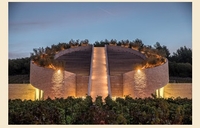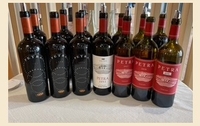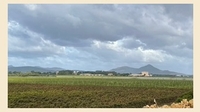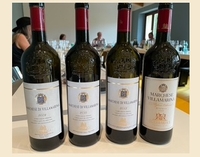“Terra Moretti Vino” got into the wine game in 1977, and now holds six Italian estates encompassing three different regions: Bellavista and Contadi Castaldi in Franciacorta (Lombardy); Petra, Tenuta La Badiola and Terruzi & Puthod in Tuscany, and Sella & Mosca in Alghero. This particular visit focused on Petra and its exquisite eponymously labeled flagship wine, and on Sella & Mosca – a more recent acquisition that the family purchased from Campari in 2016, but whose roots go back to 1899. (An important side note: Moretti appears to be a fairly common name in Italy, and there are other wine producers that use “Moretti” on their labels, so take care to note the difference.)
Petra was founded in 1997 near the town of Suvereto in the Livorno region of Tuscany, about two hours southwest of Florence and about 15 miles or so from Italy’s western coast. Elisa Bonaparte Baciocchi (Napoleon’s younger sister) once ruled in this region, and in the early 1800’s she had five hectares of vineyards planted with the Bordeaux varieties Cabernet Sauvignon, Merlot and Cabernet Franc. Petra was founded on the idea of continuing in this vein. Francesca Moretti says, “Women are the foundations of Petra: In continuing Elisa Bonaparte Baciocchi’s project, I wanted to make wines that reveal a feminine, sensitive and decisive character.” To that end, the family has planted 103 hectares in five different microclimates, continuing a focus on Bordeaux varieties and adding Sangiovese, Syrah, Vermentino, Viognier, Trebbiano and Malvasia Bianca to the mix.
Before we get into the wines, it’s worth noting that the winery itself is a  literal work of art. Petra is part of a group of fourteen wineries in Tuscany that have been designed by what they call “masters of contemporary architecture.” While I haven’t yet seen the other thirteen projects, I can say that Petra’s design, by architect Mario Botta, is both visually striking and intentionally tailored to practical aspects of winemaking, beautifully accommodating everything from crush to fermentation to storage to guest experience in one facility. I’d liken it to a stone spacecraft landing in a perfect spot that allows it to both show off and serve its purpose with utility and style. This alone makes the place worth a visit.
literal work of art. Petra is part of a group of fourteen wineries in Tuscany that have been designed by what they call “masters of contemporary architecture.” While I haven’t yet seen the other thirteen projects, I can say that Petra’s design, by architect Mario Botta, is both visually striking and intentionally tailored to practical aspects of winemaking, beautifully accommodating everything from crush to fermentation to storage to guest experience in one facility. I’d liken it to a stone spacecraft landing in a perfect spot that allows it to both show off and serve its purpose with utility and style. This alone makes the place worth a visit.
And on that visit, take the time — as I did — to sample the results of land,  people and buildings working in harmony. Here are my quick hit tasting notes on a selection of seven Petra bottlings from the 2004 vintage forward – note that each vintage is a blend of 70% Cabernet Sauvignon and 30% Merlot unless otherwise noted, with Cabernet Franc playing an integral role beginning with the 2018 vintage. Current vintage pricing is about $65.
people and buildings working in harmony. Here are my quick hit tasting notes on a selection of seven Petra bottlings from the 2004 vintage forward – note that each vintage is a blend of 70% Cabernet Sauvignon and 30% Merlot unless otherwise noted, with Cabernet Franc playing an integral role beginning with the 2018 vintage. Current vintage pricing is about $65.
Petra 2004 – An exceptional vintage showing fine balance. In this year the Cabernet Sauvignon (55%) and the Merlot (45%) ripened at the same time instead of Merlot ripening first as has been the norm. Some bricking at the edge is evident, but the wine is remarkably fresh, with a nose of deep varietal fruit character, leathery notes, and hints of balsamic. Vibrant even at this age, with a long, sapid finish. Gorgeous! 95
Petra 2006 – A powerful vintage that was warmer with more sun days, producing a more concentrated wine than the ’04. The aromatics yield balsamic notes, dried herbs and rich fruit underneath on a deep, slow draw. The palate is still quite firm, showing a soft oak toast presence and a grip that matches the fruit well. It finishes long with bold oak spice lingering. 92
Petra 2008 – Leaning quite Bordeaux-ish in character on the nose, with that same character delivered on palate. The tannins are chalky, and there is more presence of the mineral characteristics than the fruit which is rather subdued here. 90
Petra 2012 – This was a dry, hot year, with a heat wave in July/August. Petra already had gone through verasion and was able to ride the wave well. As the vineyard has aged, the wines require less oak and can take longer maceration and less aggressive extraction to find expression. The result is a very balanced wine with fruit, oak, earth, and spice tones in a more horizontal alignment. The alcohol is higher than other vintages, but is well tapered in, so no heat shows. Layered flavors linger long, with a supple grip and oak spice coming forward in finish. 92
Petra 2017 – This was described as a difficult vintage as dry weather conditions had persisted since 2015. It shows the darkest color of the group, and low yields made for a very concentrated wine featuring blackberry, cassis and dried herb aromas and flavors. It’s tightly wound and just beginning to unfurl. The tannin structure is bold but pure, which bodes well for a long life. 94
Petra 2018 – Cabernet Franc joins the mix in this current release, and it does a good job of helping to achieve Francesca Moretti’s goal of a feminine, sensitive character in the glass. The blend here is 60% Cabernet Sauvignon, 30% Merlot and 10% Cabernet Franc, and there’s a freshness that should stay with this wine for many years in the cellar. Aromatically it’s more elegant and layered than the older wines, featuring soft oak spice, cherry, blackberry, anise and a zesty citric note. The palate delivers the nose elements on a silky texture, great with push and structure that supports everything. Brava! 96
Petra 2019 – This vintage is not yet released. A good blast of rain in late July de-stressed the vines at a good time. My initial impression is one of structure, power and elegance, with red plum, blackberry, currants, Mediterranean herbs, and a balsamic note showing already. It’s got a supple texture with weight but it’s light on its feet. It’s already finishing quite long, and it’s headed for a great future. 95
Vertical tastings like this are more than just a curiosity – more than just vintage variation; they can show trends, changes in philosophy, vineyard maturity and the like…things that can show a wine buyer whether something is a good bet beyond the snapshot of one tasting at one point in time. Petra is certainly trending in a good direction, and I believe the wines represent solid value. I also tasted single variety bottlings – watch for reviews in upcoming issues.
A quick hop across the water at the end of the day brings us to Sella &  Mosca – a huge property very near the Alghero airport in Sardinia that Terra Moretti purchased from Campari in 2016. In addition to 520 hectares under vine in Alghero, holdings include a 15-hectare planting of Vermentino in Gallura (Vermentino di Gallura is the islands only DOCG) on the north eastern corner of the island, a six-hectare planting of Carignano in Sulcis on the southwest corner, and a small century-old Cannonau vineyard in Mamoaida the north central mountains at about 700 meters of elevation.
Mosca – a huge property very near the Alghero airport in Sardinia that Terra Moretti purchased from Campari in 2016. In addition to 520 hectares under vine in Alghero, holdings include a 15-hectare planting of Vermentino in Gallura (Vermentino di Gallura is the islands only DOCG) on the north eastern corner of the island, a six-hectare planting of Carignano in Sulcis on the southwest corner, and a small century-old Cannonau vineyard in Mamoaida the north central mountains at about 700 meters of elevation.
The island’s native grapes include Cannonau, Vermentino, Monica and Torbato, with international varieties Chardonnay, Sauvignon Blanc and  Cabernet Sauvignon also planted. It’s this last variety that is responsible for the winery’s flagship wine – Marchese di Villamarina, a 100% varietal offering (produced since 1989) that yield a wholly unique expression of the grape, one more focused on red fruit and herbs that ride bright acidity. It’s not at all like most new world takes on the grape, and features a unique myrtle accent, as a tasting of four vintages bore out. My quick takes:
Cabernet Sauvignon also planted. It’s this last variety that is responsible for the winery’s flagship wine – Marchese di Villamarina, a 100% varietal offering (produced since 1989) that yield a wholly unique expression of the grape, one more focused on red fruit and herbs that ride bright acidity. It’s not at all like most new world takes on the grape, and features a unique myrtle accent, as a tasting of four vintages bore out. My quick takes:
Marchese di Villamarina 2006 – at age sixteen, this is well into its more secondary, bottle bouquet stage, and a Barolo-like grip makes it a little hard to dig out the fruit, but currants and blackberry are still present under the tobacco, myrtle, and mineral notes. 90
Marchese di Villamarina 2010 – A deeply layered nose recalling red currants, cherry, cigar box, myrtle and gentle spice lead to a palate that translates the elements well over lively acidity and a supple grip. This will continue to develop, but it’s a delight right now. 95
Marchese di Villamarina 2012 – On the riper side of the group, this leans a little darker, with blackberry joining the red currants, cherry, tobacco, myrtle, and soft oak spice. It’s long and supple for a lighter take on Cabernet, and it’s a real pleasure to drink. 94
Marchese di Villamarina 2016 – This is a rich, earthy Cabernet, where the oak influence is a forward at present. The bouquet is quite deep in fruit character – a more concentrated wine yet typical of the house style. It’s still integrating the wood, so give it some time– it should integrate well and turn elegant. 92
The current vintage retails for around fifty dollars, and it’s certainly a singular take on Cabernet that will intrigue fans of the variety. I’ll have reviews of other Sella & Mosca products – the Torbato in particular – in forthcoming issues.
Hospitality is clearly a focus at both houses, with multiple experiences on offer including on premise accommodations. At Sella & Mosca, the Casa Villamarina is a 14 room bed-and-breakfast renovated by Valentina Moretti, and a stay gives visitors a chance to drink in the fresh sea breeze while surrounded by vineyards on the historic property.
The Moretti family is to be commended for an obvious commitment to quality, sustainability and hospitality at these two estates – I highly recommend a visit to both, and you can bet I’ve got their other properties on my list for future exploration. Salute!
